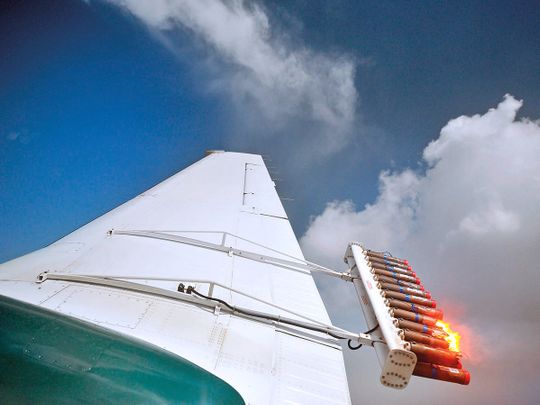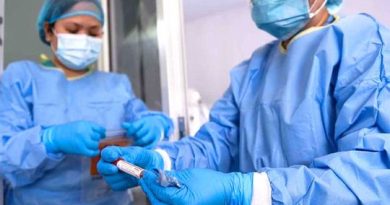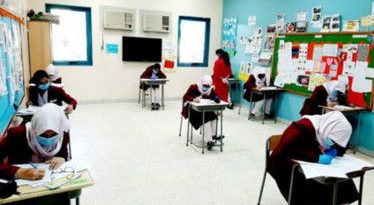Rain in UAE: UAE tests efficiency of new cloud seeding material in Texas
[ad_1]

Image Credit: Supplied
Abu Dhabi: The UAE Rain Enhancement Programme (UAEREP) has launched a flight campaign in Texas, United States, to investigate the effect of novel cloud seeding nanomaterial.
The open atmosphere airborne tests aim to measure the effect of the material on droplet size distribution and ultimately the rainfall generation process.
See more
-
More COVID-19 rapid screening centres opened with Dhs50 per test
-
Dubai Metro turns 11 years old today
-
Photos: Gulf News reader shares his favourite travel destinations in the UAE, Colombia, Cuba, Mexico, New Zealand, Singapore and Australia
-
UAE-Israel peace deal signing ceremony in pictures
-
News in pictures: Amazon to hire 100,000 people, Kerala gold smuggling, Sally to hit Mexico, Russia vaccine, UAE mid-day break, Delhi COVID tests…
The UAEREP’s studies, overseen by the National Centre of Meteorology (NCM), are the culmination of successful laboratory-scale experiments and modelling studies carried out over the past four years, as well as the tests that took place in Abu Dhabi last year.
Two projects
The campaign is a combined effort leveraging research outcomes and capabilities from two UAEREP projects. Developed by Professor Linda Zou at Khalifa University and one of the three awardees of the Programme’s First Cycle, the innovative cloud seeding material is being tested by Dr Paul Lawson, senior research scientist at SPEC Incorporated, US, and one of the programme’s second cycle awardees.
New nanomaterial developed
Prof Zou’s project aimed to improve the effectiveness of cloud seeding technologies to increase rain precipitation, through engineering nanostructured properties of the cloud seeding material. This helps water vapour to condense in clouds in a process necessary for raindrops to form. The project successfully developed and patented a customised nanomaterial composite that was shown to enhance precipitation formation during both modelling studies and lab experiments. The project also identified the required technology and procedures for cost-effective production of this material to meet actual cloud seeding mission quantity demands.
Choice of city
Texas was selected for the campaign due to its cleaner atmosphere, providing a better opportunity to observe the microphysical impacts of the nanomaterial in the warm portion of convective clouds, similar to those being seeded over the UAE. This will also ensure the effectiveness of the material in different atmospheric environments, in line with UAEREP’s promising plan to mass-produce the nanomaterial and propose them to operational cloud seeding programs worldwide.
“Our planned testing campaign articulates the NCM’s continued efforts to develop innovative solutions to address the pressing global water-stress challenges. Since its inception, the UAEREP has developed extensive expertise in rain enhancement to ensure sustainable sources of water. At NCM, we are committed to employing the findings of our groundbreaking research projects for the benefit of arid and semi-arid regions around the world,” Dr Abdulla Al Mandous, NCM director and president of the Regional Association II in the Asia Region.
Nanoparticle testing
This campaign is an important part of the implementation and testing plan of the NCM, which consists of a titanium dioxide nanoparticle layer coated on the salt crystals. The project has already led to innovative hydrophilic and hygroscopic cloud seeding materials being designed and fabricated.
Experimental results obtained so far through laboratory testing and analysis suggest that this material has a much higher ability to initiate condensation of water vapour and droplet growth in the clouds than the salt crystals that are currently used for rain enhancement in the UAE.
Equipped Learjets
The testing campaign uses a SPEC custom-designed Learjet research aircraft equipped with sophisticated cloud physics instrumentation, which is also used in various campaigns across the world. The instruments can collectively monitor the growth of fine-mode aerosols to cloud droplets, and eventually mm-sized rain drops.
Testing procedure
As part of the project, two to three flights, each lasting up to three hours, will be deployed, using a minimum of two flares for each cloud penetration, depending on individual cloud conditions. A total of 40 flares have been dedicated for the flight campaign, which will be conducted in coordination with the Texas Water District cloud seeding aircraft.
The seeding aircraft will fly under cloud base and either ignite two flares in the updraft, or fly under cloud base without releasing any seeding material. The Learjet will break to the right and proceed to penetrate the cloud approximately 500 to 1,000 feet above the cloud base to intersect the seeding plume in the updraft. A minimum of five clouds will be penetrated by the Learjet to obtain natural (unseeded) background conditions for comparison with the seeded clouds.
[ad_2]
Source link


